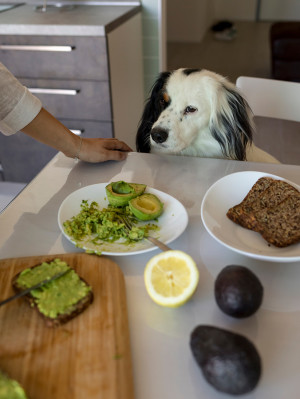Can Dogs Eat Grapes?
The answer is no, no, no, and here’s why.

share article
If you think your dog should be able to luxuriate in a fine charcuterie board, complete with all kinds of fruits, meats, and cheeses, you clearly think of your dog as the royalty they are, but please take a pause before you let them get anywhere near grapes, or their wrinkly counterparts, raisins.
Dogs should never eat grapes or raisins because even small amounts can be toxic to them. Even though they seem like an easy snack that dogs love, grapes can cause kidney damage and other problems.
Nutrition Facts: Grapes For Dogs
Although grapes are a convenient snack with numerous possible health benefits for humans, they should never be fed to dogs. This may be surprising to some dog parents who have given their dogs grapes for years without any obvious issues developing. This unpredictable danger troubled toxicologists for years and made it difficult for them to figure out why grapes were harming dogs.
Researchers recently discovered that tartaric acidopens in a new tab is the likely culprit that causes grapes to be toxic. Tartaric acid is commonly known as cream of tartar, which has many uses in baking. Grapes naturally contain more tartaric acid than most fruits, though the amount of it present in each grape varies widely.
This wide variation in the amount of the toxin partially explains why some dogs get sick when eating relatively few grapes, while others do not develop any issues. It is also suspected that some dogs are more sensitive to tartaric acid than others, though this hasn’t been proven definitively. Because there’s so much variability in the toxin profile, vets consider any ingestion of grapes by a dog as dangerous.
Are grapes good for dogs?
Grapes are toxic to dogs. Ingestion of just a few grapes has caused kidney failure in dogs. Early signs of grape toxicityopens in a new tab include:
Left untreated, the toxicity can progress and cause more serious issues like:
Decreased urine output
Abdominal pain
Grapes can also cause neurological changes in dogs, making them weak or unsteady on their feet. Fortunately, these neurological symptoms are reversible and should not persist long-term. The damage to the kidneys may or may not be permanent, depending on how quickly the problem is recognized and the dog’s response to treatment.
Can dogs eat grape skins?
All parts of the fruit of the grape — including the skin, flesh, and seeds — are considered toxic and unsafe for dogs. There have not been reported cases of toxicity from dogs eating grape leaves or grape vines, but it’s probably best to avoid those too, just in case. Plus, what dog wants to eat grape leaves?
Are grapes completely safe for dogs?
Grapes are not safe for dogs to eat at all, and dogs who have eaten grapes should see a veterinarian as soon as possible for treatment. The type of treatment needed varies depending on the size of the dog and the number of grapes they’ve eaten.
Veterinarians will usually give dogs medication to make them vomit, even if the grapes were eaten many hours previously. The toxin present in grapes slows emptying of the stomach, so it’s sometimes possible to recover some of the material from the stomach well after it would normally have passed into the intestines.
The treatment for grape toxicity focuses on protecting the kidneys from the harmful effects of the toxin. This involves diuresis, in which dogs are administered more fluids than they need so that there is a constant flow of urine through the kidneys. Proper diuresis requires a hospital stay and monitoring of kidney values to make sure the treatment is effective. Depending on the number of grapes ingested and the guilty dog’s size and medical history, other options for treatment may also be presented.
The bottom line: Can dogs eat human foods?
Many human foods are safe for dogs in small amounts, but grapes are definitely not one of them. While they are the perfect size for many dogs, they should not be used as a treat, even in small amounts. Treats made specifically for dogs are usually the safest bet for a reward, but it’s always hard to resist sharing a little bit of what you’re eating from your plate.
Knowing what alternatives are safe for dogs is key to safe snacking. Moderation is also important: Treats and human foods should make up less than ten percent of your dog’s calorie intake for the day to maintain optimal dietary balance. Any new food can cause stomach upset, so start off slowly with anything your dog hasn’t tried to make sure they can tolerate it.
Other Fruits That Are Safe For Dogs
Remember that fruits are generally high in sugar, so they should be kept very limited in dogs with diabetesopens in a new tab or obesityopens in a new tab. Always check with your vet before starting a new snack if your dog has any health issues because some surprising interactions can pop up. Fruit should not make up a significant part of any dog’s diet, but sharing a bite of these fruits every once in a while can be OK.
Blueberries: Blueberries are the perfect size for many dogs, making them an easy snack to share. Blueberries are high in fiber and vitamin C. When frozen, they become a crunchy, cool treat for the summer months.
Apples or applesauceopens in a new tab: Apples are also packed with fiber and vitamin C. They need to be cut into pieces of an appropriate size for your dog because they can pose a choking hazard if gulped down too quickly. Many dogs prefer the texture of a spoonful of applesauce to whole apple pieces. Just buy the unsweetened stuff to cut down on the extra calories.
Bananas: Some dogs just love the taste of a ripe banana. Bananas are high in potassium and fiber. They do contain a good bit of sugar though, so try to limit things to a couple of slices when you’re sharing. Don’t be tempted to give your dog the banana peel, though. They’re not toxic, but they do pose a choking hazard and can cause an intestinal obstruction because they don’t break down well in the stomach.
Other Fruits That Could Be Dangerous to Dogs
Avoid feeding these other toxic fruits to your dog and always keep them out of areas where your dog can reach them.
Raisinsopens in a new tab: Unsurprisingly, dried grapes aren’t great for dogs either. The toxin in grapes isn’t eliminated when they’re dehydrated to make raisins. In fact, raisins will contain more of the toxin by weight.
Tamarinds: Tamarinds are a sweet, tangy fruit commonly used in Mexican, Indian, and Middle Eastern dishes. Tamarinds contain an even higher amount of the tartaric acid that makes grapes and raisins so toxic.
Citrus: Citrus fruitsopens in a new tab aren’t directly toxic to dogs, but the essential oils present in the rinds, leaves, and stems can cause vomiting opens in a new taband diarrheaopens in a new tab. Dogs aren’t usually big fans of the tart flavor of citrus anyway, so skip this treat.
FAQs (People Also Ask):
How many grapes can a dog eat?
Because grapes contain a very variable amount of the ingredient that makes them toxic, there is no safe number of grapes to feed a dog.
Is it OK to give dogs grapes?
Dogs should never be given grapes because they could cause damage to their kidneys.
Why do dogs like grapes?
Dogs may enjoy the flavor or crunch of grapes, but it’s their parents’ job to find a safer snack for them.
References

Dr. Bartley Harrison, DVM
Dr. Bartley Harrison, DVM is a small animal veterinarian based in North Carolina who has practiced emergency medicine since graduating from the Texas A&M College of Veterinary Medicine. His primary interest areas include pain management, cardiology, and the treatment of shock.
He is a member of the Veterinary Emergency and Critical Care Society, American Veterinary Medical Association, and American Medical Writers Association. In addition to his clinical work, he writes pet health articles to help provide accurate information for both new and experienced pet parents. When he’s not working, he enjoys cooking, traveling, reading, and going on adventures with his dog.
Related articles
![Pet owner feeding white rice to her Shih Tzu dog.]() opens in a new tab
opens in a new tabCan Dogs Eat Rice? And More Importantly, Should They?
Yes, actually. Just follow these guidelines.
![Golden retriever looks at some eggs on the counter]() opens in a new tab
opens in a new tabCan Dogs Eat Eggs?
Get that protein, bro.
- opens in a new tab
Can My Dog Eat Honey? Learn If Honey Is Beneficial or Harmful For Dogs
They shouldn’t exactly have their paw constantly in the honey jar, but the sweet stuff can be beneficial in some cases.
- opens in a new tab
Can Dogs Eat Avocado?
Hold the avo toast, please.
![View over the shoulder of a women eating peanut butter and bananas and feeding some of the peanut butter to her dog on a spoon]() opens in a new tab
opens in a new tabPeanut Butter Is the Best Snack. Can Your Dog Have It?
Elvis famously loved peanut butter. So, can your “Hound dog” lap it up, too?
- opens in a new tab
Can Dogs Eat Strawberries?
In moderation, strawberries are a tasty, healthy treat for your pup.









